Evolution and Collapse of Ejidos in Mexico—To What Extent Is Communal Land Used for Urban Development?
Abstract
1. Introduction
2. Theoretical Framework—Stakeholders as Agents of Socio-Spatial Change
3. Historical Background—the Ejido Land Tenure System Approach
- Communal land—the pre-Hispanic ejido and Altépetl (“Water-mountain” in Náhuatl language, was a complex socio-spatial and political system that gave order to former Mesoamerican cities. Each Altépetl had its own government as a City state and its own communal land outside the core areas for agricultural purposes. This was the primordial land tenure system in Mesoamerica and one of the factors influencing modern ejido implementation) system;
- Public land—owned by the Spanish Crown;
- Private land—owned by the Church and property owners or hacendados, which represented the new upper-middle-agrarian class.
4. Methods—Quantification and Analysis of Case Study Areas
4.1. Case Study Descriptions
4.2. Geo-Visual Analysis from Satellite Images
5. Results and Discussion
5.1. First Statement—Ejido Land Was and Still Is Potential Privately Developable Land
5.2. Second Statement—Land Tenure Changes Benefit Private Developers
5.3. Third Statement—Spatial Segregation beyond Peri-Urban Morphology
6. Conclusions
Author Contributions
Funding
Acknowledgments
Conflicts of Interest
References
- Appendini, K., II. La transformación de la vida rural en tres ejidos del centro de México (II. The transformation of rural life in three ejidos in central Mexico). Rural. Sin Agric. 2008, 27–58. [Google Scholar]
- Simpson, E.N. The Ejido: Mexico’s Way Out. Ph.D. Thesis, The University of North Carolina, hapel Hill, NC, USA, 1937. [Google Scholar]
- Warman, A. El Campo Mexicano en el Siglo; Fondo de Cultura Ecónomica: Mexico City, Mexico, 2001. [Google Scholar]
- Karst, K.L.; Clement, N.C. Legal institutions and development: Lessons from the Mexican Ejido. Ucla L. Rev. 1968, 16, 281. [Google Scholar]
- Singelmann, P. Rural collectivization and dependent capitalism: The Mexican collective Ejido. Lat. Am. Perspect. 1978, 5, 38–61. [Google Scholar] [CrossRef]
- Cord, L.; Wodon, Q. Do agricultural programs in Mexico alleviate poverty? Evidence from the ejido sector. Cuad. Econ. 2001, 38, 239–256. [Google Scholar] [CrossRef]
- Torres-Mazuera, G. La territorialidad rural mexicana en un contexto de descentralización y competencia electoral. Rev. Mex. Sociol. 2009, 71, 453–490. [Google Scholar]
- Torres-Mazuera, G. Transformación identitaria en un ejido rural del Centro de México. Reflexiones en torno a los cambios culturales en el nuevo contexto rural. Rural. sin Agric. 2008, 239–255. [Google Scholar]
- Méndez-Lemus, Y.; Vieyra, A.; Poncela, L. Periurbanization, Agricultural Livelihoods and Ejidatarios Social Capital: Lessons from a Periphery Municipality in Michoacán, Mexico. Procedia Eng. 2017, 198, 428–443. [Google Scholar] [CrossRef]
- Jones, G.A.; Ward, P.M. Privatizing the commons: reforming the ejido and urban development in Mexico. Int. J. Urban Reg. Res. 1998, 22, 76–93. [Google Scholar] [CrossRef]
- Olivera, G. La Urbanización Social y Privada del Ejido. Ensayos Sobre la Dualidad del Desarrollo Urbano en México; Universidad Nacional Autónoma de México: Mexico City, Mexico, 2015. [Google Scholar]
- Iracheta, A.X. Acceso a terrenos con servicios para los pobres urbanos: la paradoja de la regularización en México. Econ. Soc. Y Territ. 2000, II, 754–789. [Google Scholar] [CrossRef]
- Alarcón, A.R. La organización ejidal en el desarrollo rural de México. Estud. Agrar. 2015, 59, 181–204. [Google Scholar]
- Stanford, L. The privatization of Mexico’s ejidal sector: Examining local impacts, strategies and ideologies. Urban Anthropol. Stud. Cult. Syst. World Econ. Dev. 1994, 23, 97–119. [Google Scholar]
- De Grammont, H.C. El campo mexicano a finales del siglo XX (The Mexican Countryside in the Late 20th Century). Rev. Mex. Sociol. 2001, 81–108. [Google Scholar] [CrossRef]
- Morett-Sánchez, J.C.; Cosío-Ruiz, C. Panorama de los ejidos y comunidades agrarias en México. Agric. Soc. y Desarro. 2017, 14, 125–152. [Google Scholar] [CrossRef]
- Warman, A. Mexican land reform: a long-term perspective. L. Reform L. Settl. Coop. 2003, 84, 95. [Google Scholar]
- Schumacher, M. Peri-urban development in Cholula, Mexico: towards a socio-spatial management model. Ph.D. Thesis, Technische Universität München, München, Germany, 2016. [Google Scholar]
- Barnes, G. The evolution and resilience of community-based land tenure in rural Mexico. Land Use Policy 2009, 26, 393–400. [Google Scholar] [CrossRef]
- Vázquez, C.G. Teorías e Historia de la Ciudad Contemporánea; Editorial Gustavo Gili: Barcelona, Spain, 2016. [Google Scholar]
- Font, A. L’explosió de la Ciutat: Transformacions Territorials Recents en les Regions Urbanes de l’Europa Meridional; Col-legi d’Arquitectes Catalunya: Barcelona, Spain, 2004. [Google Scholar]
- Lefebvre, H. The production of Space (1991). In The People, Place and Space Reader, 1st ed.; Jack Gieseking, S.S., Mangold, W., Katz, C., Low, S., Eds.; Routledge: London, UK, 2014. [Google Scholar]
- The World Bank. “Stakeholder Analysis,” What is Stakeholder Analysis? 2001. Available online: http://www1.worldbank.org/publicsector/anticorrupt/PoliticalEconomy/stakeholderanalysis.htm. (accessed on 13 August 2019).
- Schmeer, K. Guidelines for Conducting a Stakeholder Analysis. 1999: Bethesda, USA. Available online: https://www.who.int/management/partnerships/overall/GuidelinesConductingStakeholderAnalysis.pdf (accessed on 21 July 2019).
- Pírez, P. Actores sociales y gestión de la ciudad. Rev. Ciudad. 1995, 28, 8–14. [Google Scholar]
- López-Tamayo, N.E. a Urbanización Periférica mercado de suelo urbanización popular en la Ciudad de Puebla entre 1970 y 1990. Ph.D. Thesis, UNAM, Mexico City, Mexico, 1995. [Google Scholar]
- Harvey, D. Rebel Cities:From the Right to the City to the Urban Revolution; Verso: London, UK, 2012. [Google Scholar]
- Wilkie, J.W.; Hammond, M. Primera Reforma Agraria en México, 1853-1909, a través de la estadística nacional. Mex. World. 1998, Volume 3. Available online: http://www.profmex.org/mexicoandtheworld/volume3/3summer98/laestadistica_economicap2.html (accessed on 21 July 2019).
- Katz, F. La Guerra Secreta en México; Ediciones ERA: Mexico City, Mexico, 1982. [Google Scholar]
- Assennatto Blanco, P.; de Leon Mojarro, S. La democracia interna en el ejido. Estud. Agrar. 1996, 2, 117–132. [Google Scholar]
- De Diputados, C. Ley Agraria. H. Congreso de la Unión. 2017. Available online: http://www.diputados.gob.mx/LeyesBiblio/pdf/13_250618.pdf. (accessed on 18 July 2019).
- Robles, H.M. Tipología de los sujetos agrarios Procede. Estud. Agrar. 1996, 4, 11–39. [Google Scholar]
- Ake, C.; Flores, M.J.D.F. Análisis de la privatización de la tierra de régimen social en México. (Bachelor thesis); Universidad Autónoma Agraria Antonio Narro: Saltillo, Mexico, 2007; Available online: http://repositorio.uaaan.mx:8080/xmlui/bitstream/handle/123456789/920/T16538%20COLLI%20%20AKE%2C%20JUAN%20GABRIEL%20%20MON.pdf?sequence=1&isAllowed=y (accessed on 21 July 2019).
- Perramond, E.P. The rise, fall and reconfiguration of the Mexican ejido. Geogr. Rev. 2008, 98, 356–371. [Google Scholar] [CrossRef]
- Verea, M. Immigration trends after 20 years of NAFTA. Norteamérica 2014, 9, 109–143. [Google Scholar] [CrossRef][Green Version]
- Riveros, L. La incorporación de terrenos ejidales y comunales al desarrollo urbano. México Procur. Agrar. 2000, 9, 87–124. [Google Scholar]
- Haenn, N. The changing and enduring ejido: a state and regional examination of Mexico’s land tenure counter-reforms. Land Use Policy 2006, 23, 136–146. [Google Scholar] [CrossRef]
- De la Federación, D.O. Solicitud de expropiación de terrenos pertenecientes al ejido Santiago Momoxpan de San Pedro Cholula, antes Cholula, Pue. Diario Oficial de la Federación. Available online: http://www.dof.gob.mx/nota_detalle.php?codigo=4646595&fecha=27/01/1992. (accessed on 26 March 2019).
- De la Federación, D.O. Decreto por el que se expropia por causa de utilidad pública una superficie de terrenos de temporal de uso común del poblado San Bernardino Tlaxcalancingo, Municipio de San Andrés Cholula, Pue,” Diario Oficial de la Federación. Available online: http://dof.gob.mx/nota_detalle.php?codigo=4664172&fecha=04/05/1992. (accessed on 26 March 2019).
- Aguirre, A.M. Megaproyecto de Salinas y Bartlett; Proceso: Mexico City, Mexico, 1993; Available online: https://www.proceso.com.mx/162157/megaproyecto-de-salinas-y-bartlett (accessed on 21 July 2019).
- Secretaría de Finanzas y Administración. Actualización del Programa Regional de Desarrollo, Región Angelópolis 2011–2017; Gobierno del Estado de Puebla: Puebla, Mexico, 2011. [Google Scholar]
- Programa Regional de Ordenamiento Territorial Angelópolis; Puebla: Mexico City, Mexico, 1993.
- Agbel, C.E. Programa Municipal de Desarrollo urbano Sustentable de San Andrés Cholula 2014-2018; Ayuntamiento de San Andrés Cholula: San Andrés Cholula, Mexico, 2018. [Google Scholar]
- INEGI. Actualización del marco censal agropecuario 2016. Available online: www.inegi.gob.mx (accessed on 10 May 2019).
- CONAPO. Delimitación de las zonas metropolitanas de México 2015, 2018th ed.; SEGOB, SEDATU, CONAPO: Mexico City, Mexico, 2018. [Google Scholar]
- INEGI. Encuesta Intercensal 2015; INEGI México: Mexico City, Mexico, 2015. [Google Scholar]
- INEGI. Puebla Resultados Definitivos VII Censo Ejidal; INEGI: Mexico City, Mexico, 1994. [Google Scholar]
- Olofsson, P.; Foody, G.M.; Herold, S.V.; Stehman, C.E.; Woodcock; Wulder, M.A. Good practices for estimating area and assessing accuracy of land change. Remote Sens. Environ. 2014, 148, 42–57. [Google Scholar] [CrossRef]
- Hernández, G. Define congreso límites entre municipios de Puebla y Cholula. Proceso, 6 December 2018. [Google Scholar]
- Ruiz, L. Crece 813 pesos valor catastral de Angelópolis y Atlixcáyotl. E-Consulta, Puebla. 2018. Available online: https://www.e-consulta.com/nota/2018-12-12/economia/crece-813-pesos-valor-catastral-de-angelopolis-y-atlixcayotl (accessed on 10 may 2019).
- Santos, P.V. Por la Buena o Por la mala’ El Estado y la Lucha por la Tierra en Santa Maria Tonantzintla, Puebla. Una Historia Ejidal (Bachelor thesis) Universidad de las Américas Puebla. 2005: Cholula, Mexico. Available online: http://catarina.udlap.mx/u_dl_a/tales/documentos/laac/velasco_s_p/ (accessed on 14 June 2019).
- Zonificación Catastral, Tablas de Valores Unitarios de Suelos y Valores Catastrales de Construcción de Puebla; Gobierno del Estado de Puebla, Secretaría General de Gobierno: Puebla, Mexico, 2017.
- Terrenos en Venta en Reserva Territorial Atlixcáyotl, San Andrés Cholula. 2019. Available online: https://www.inmuebles24.com/terrenos-en-venta-en-reserva-territorial-atlixcayotl.html (accessed on 23 July 2019).
- Solà Morales Rubio, M. Las Formas de Crecimiento Urbano; Universitat Politècnica de Catalunya: Barcelona, Spain, 1997. [Google Scholar]
- Borja, J.; Muxí, Z. El espacio Público: Ciudad y Ciudadanía; Electa Editores: Barcelona, Spain, 2003. [Google Scholar]
- United Nations. New Urban Agenda; United Nations: New York City, NY, USA, 2017. [Google Scholar]
- Committee on World food Security. Principles for responsible investment in Agriculture and Food Systems; Committee on World food Security: Rome, Italy, 2014. [Google Scholar]
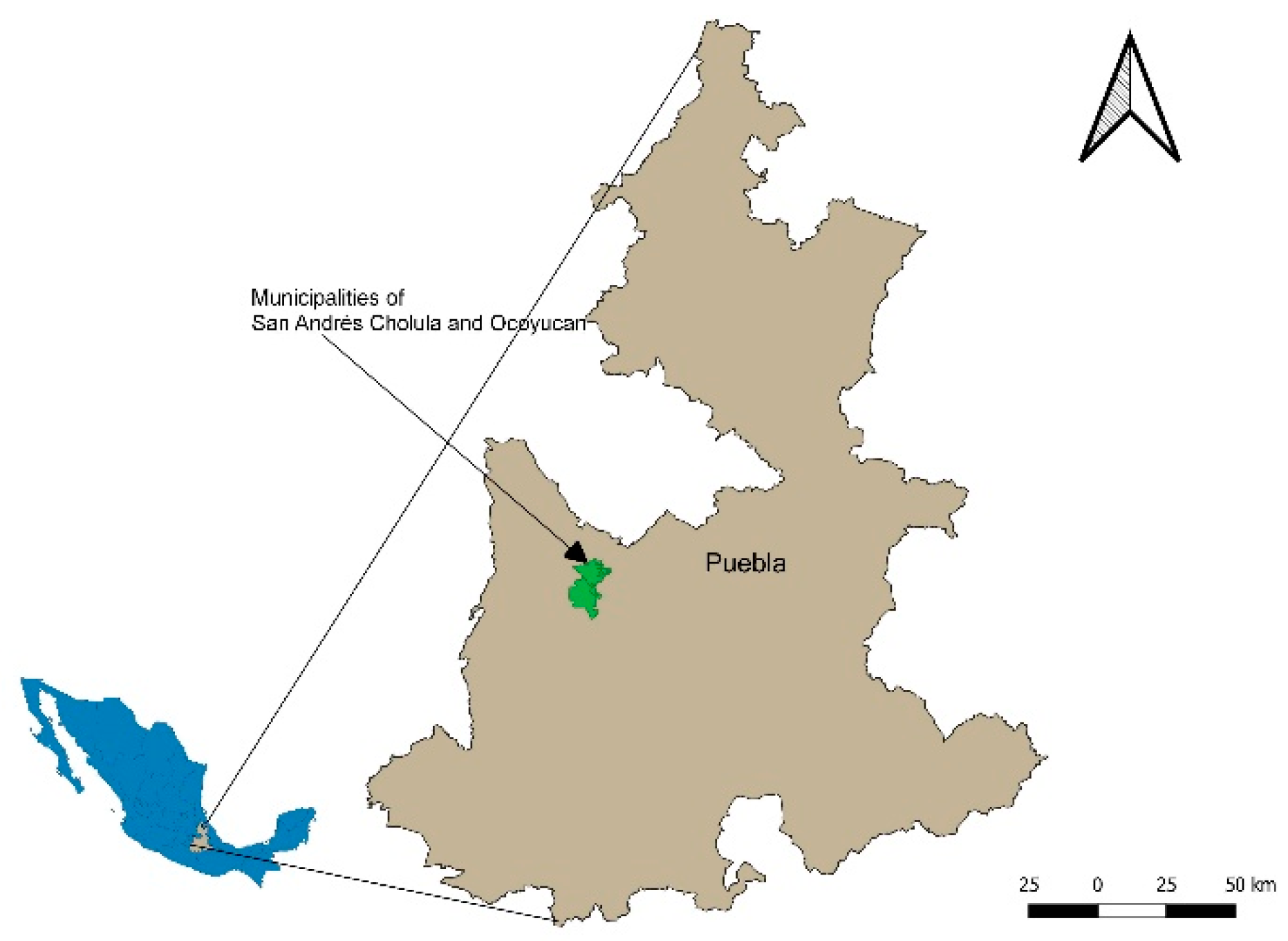
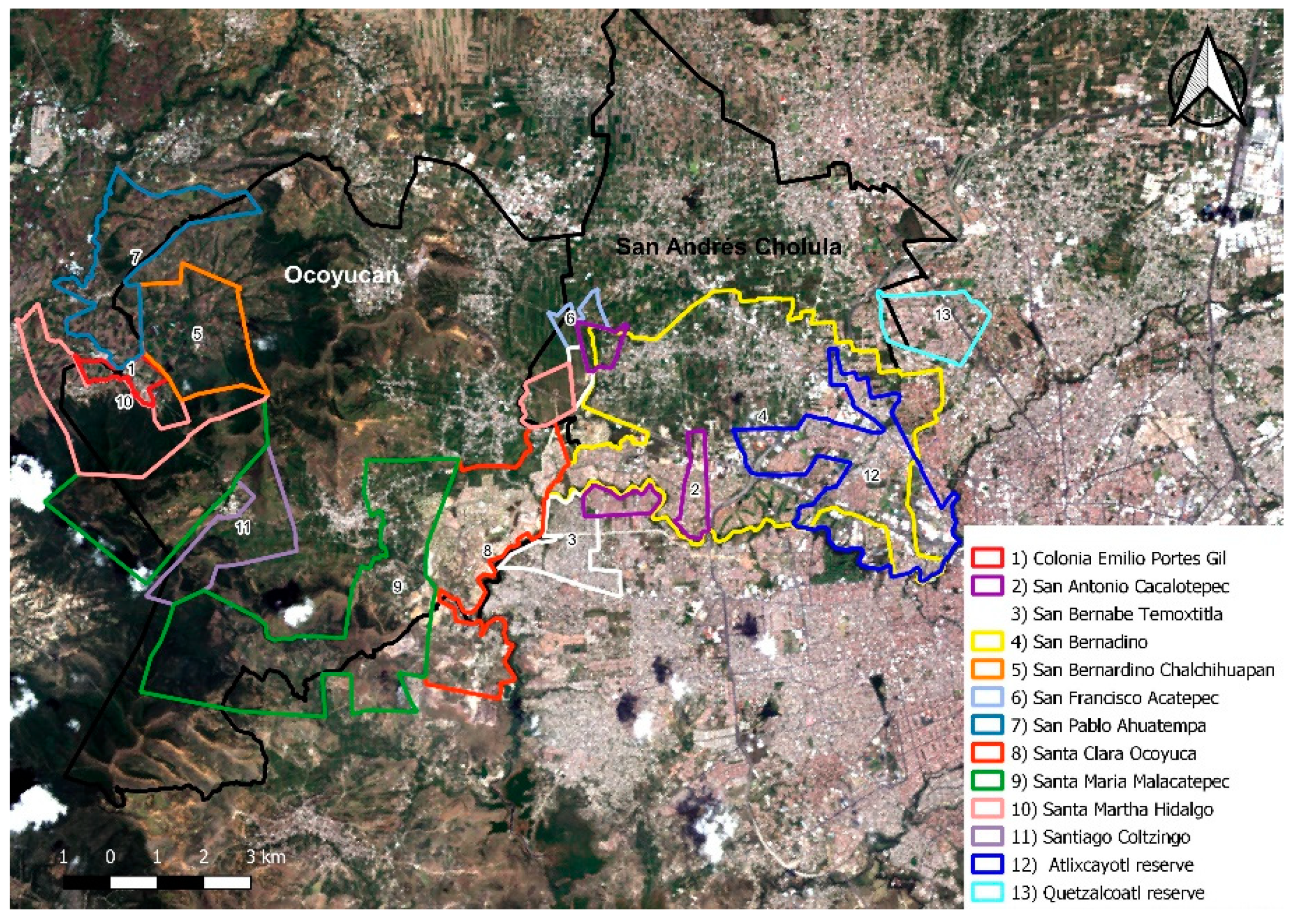
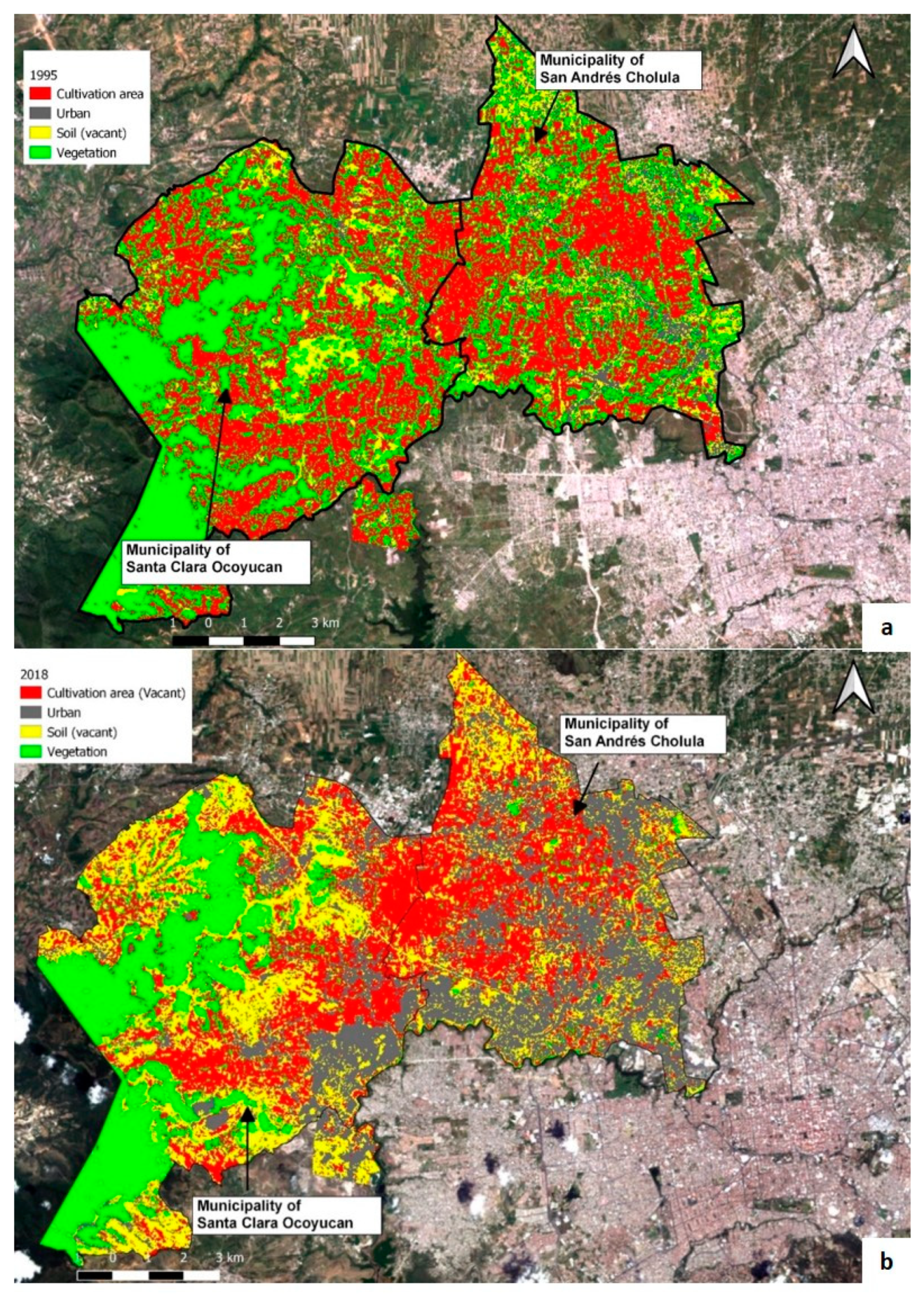
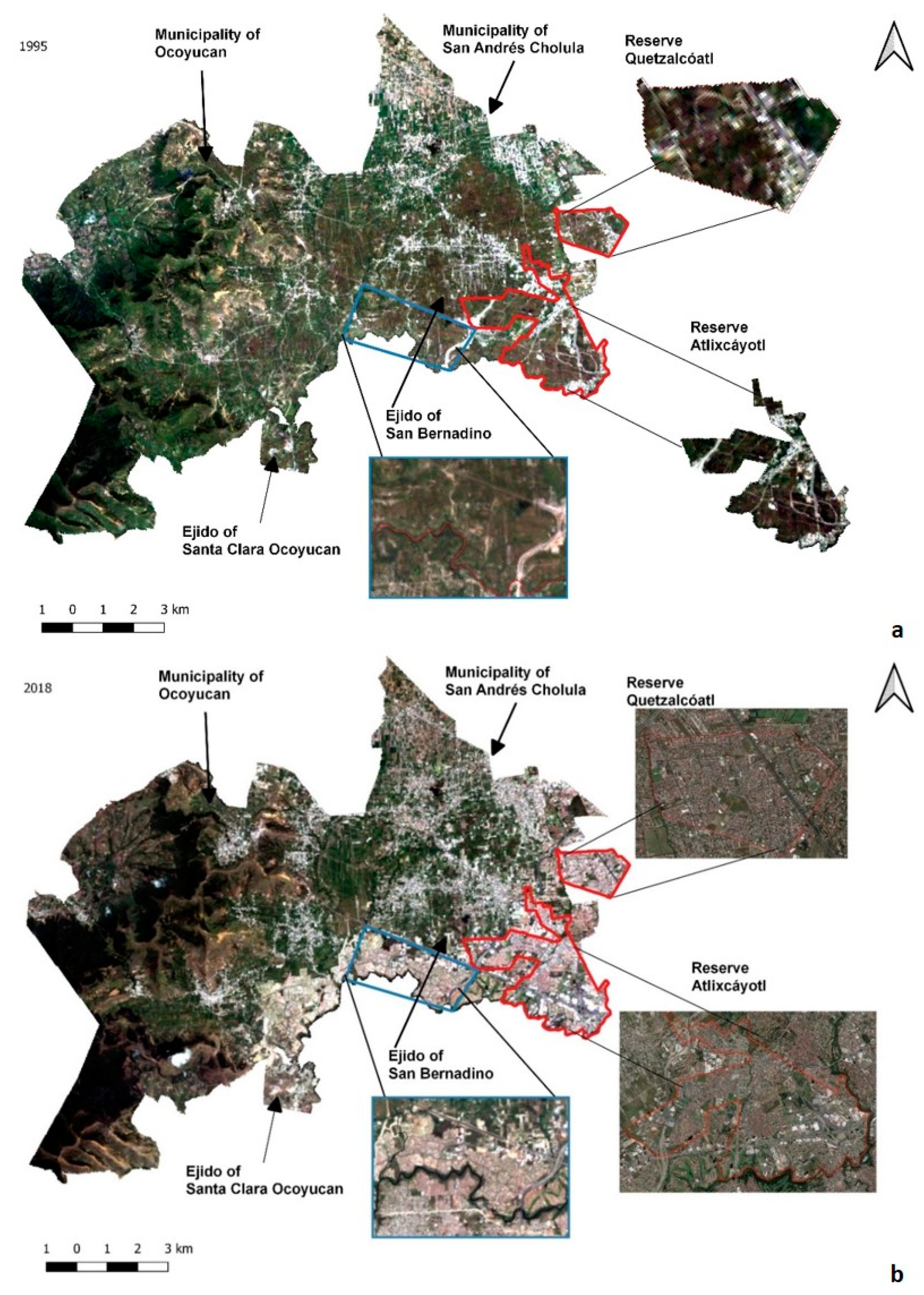
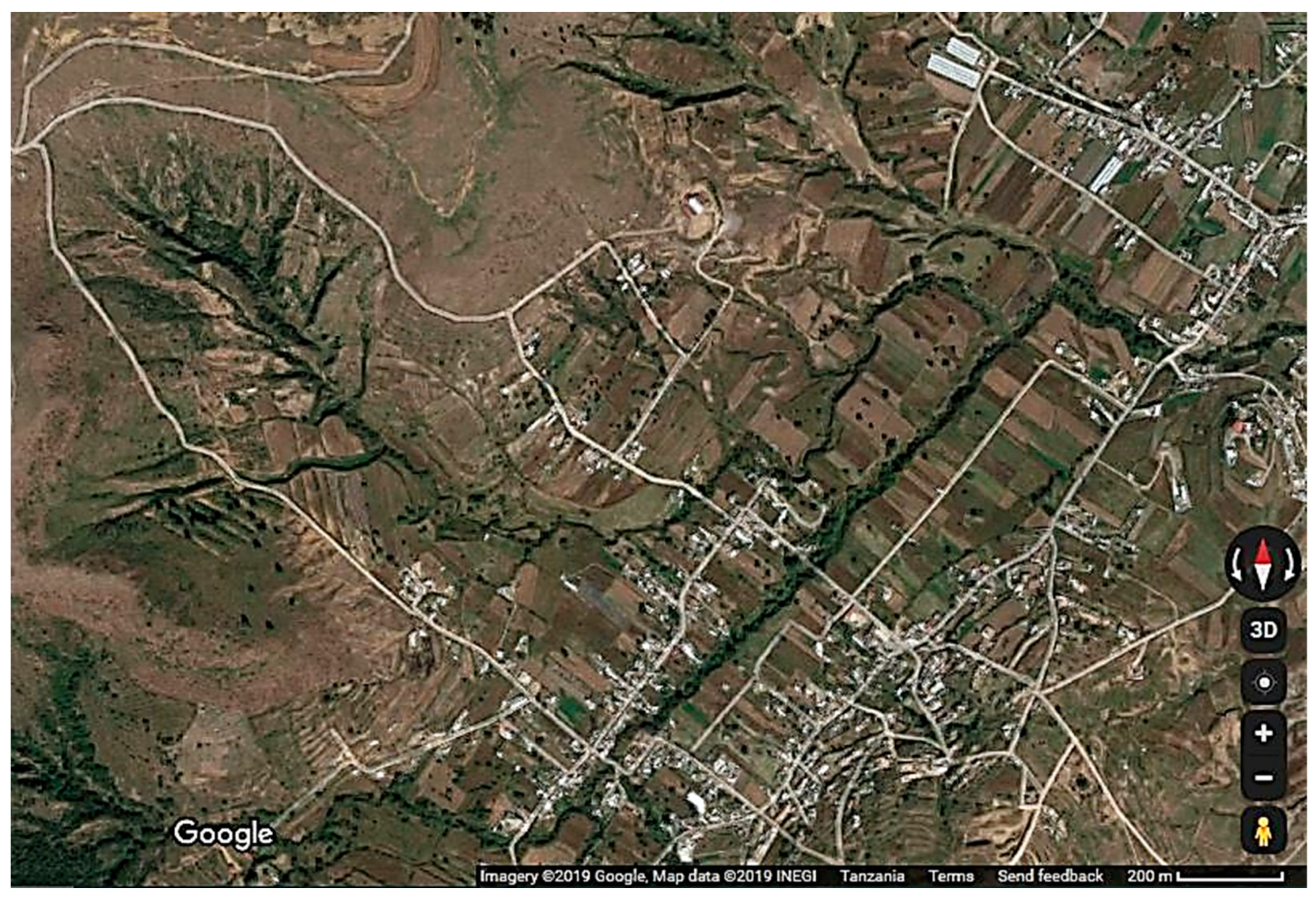
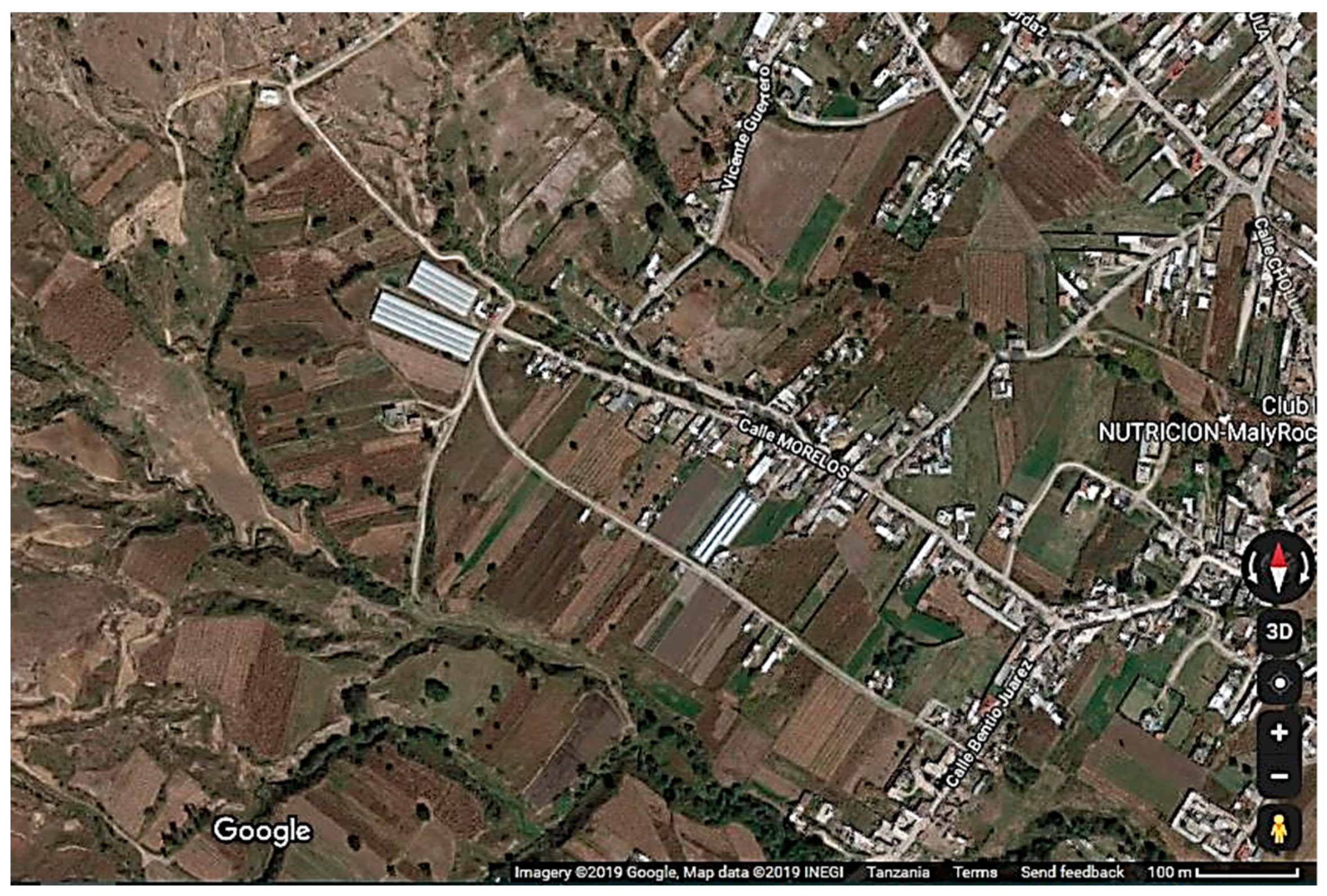
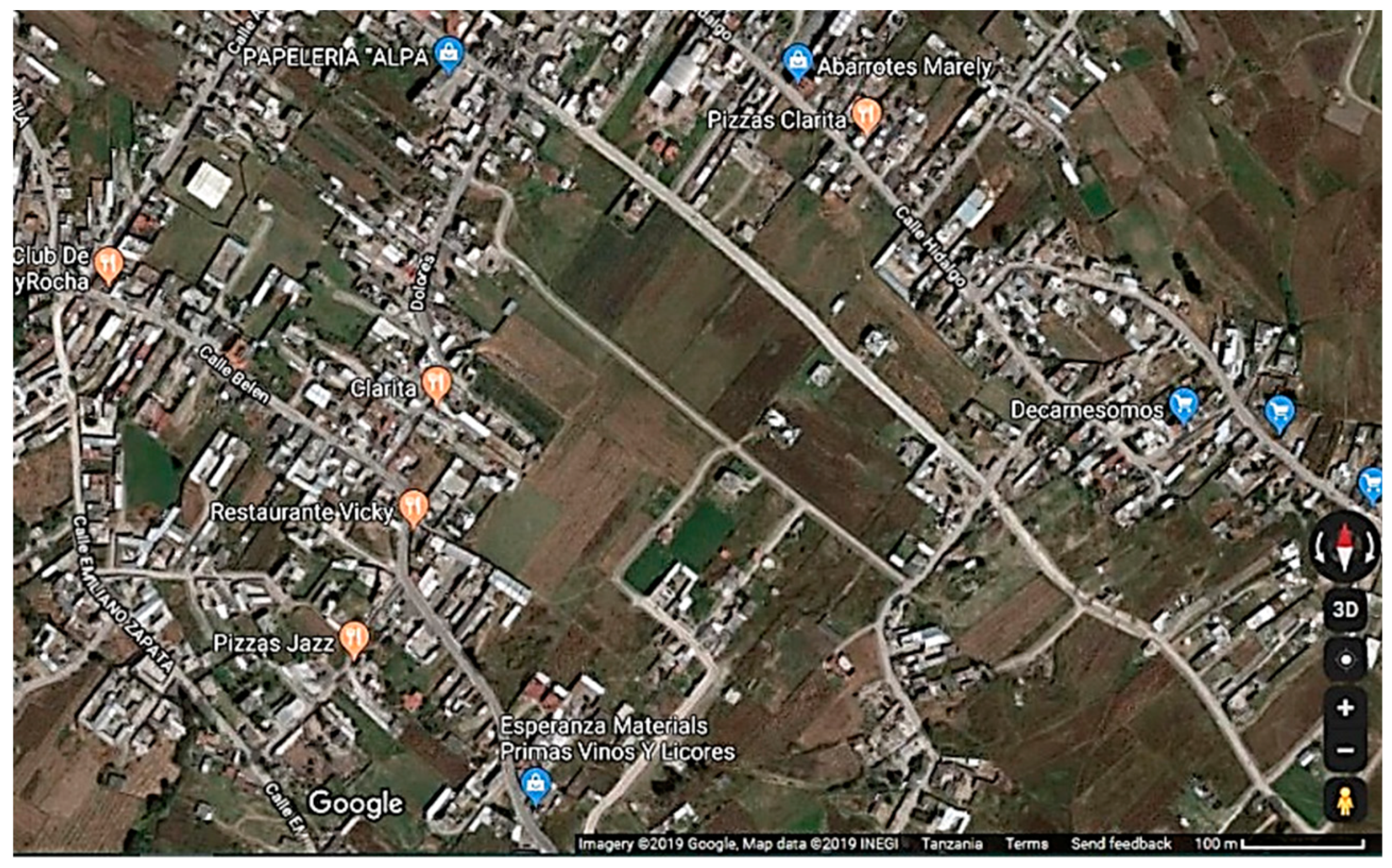
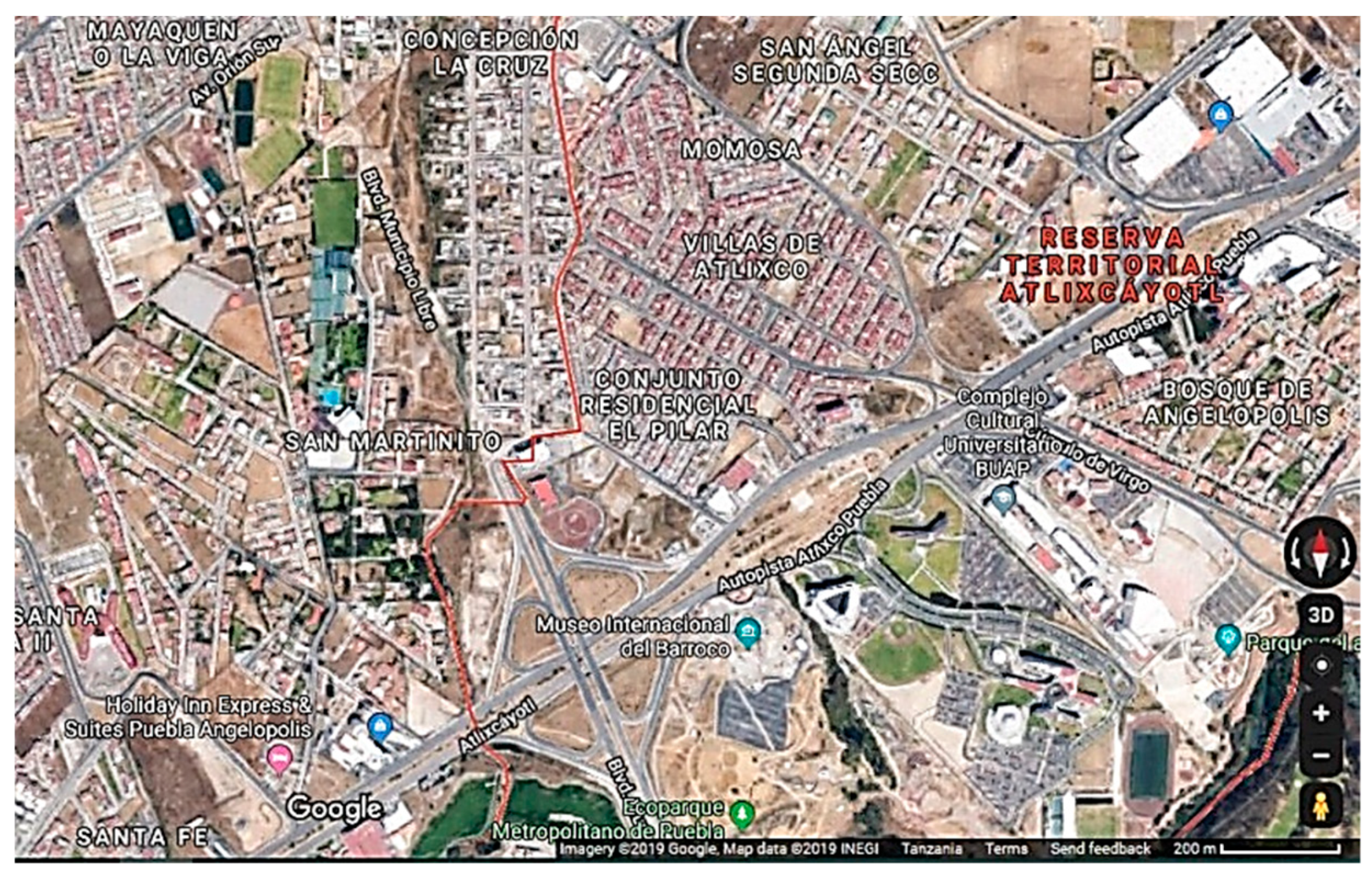
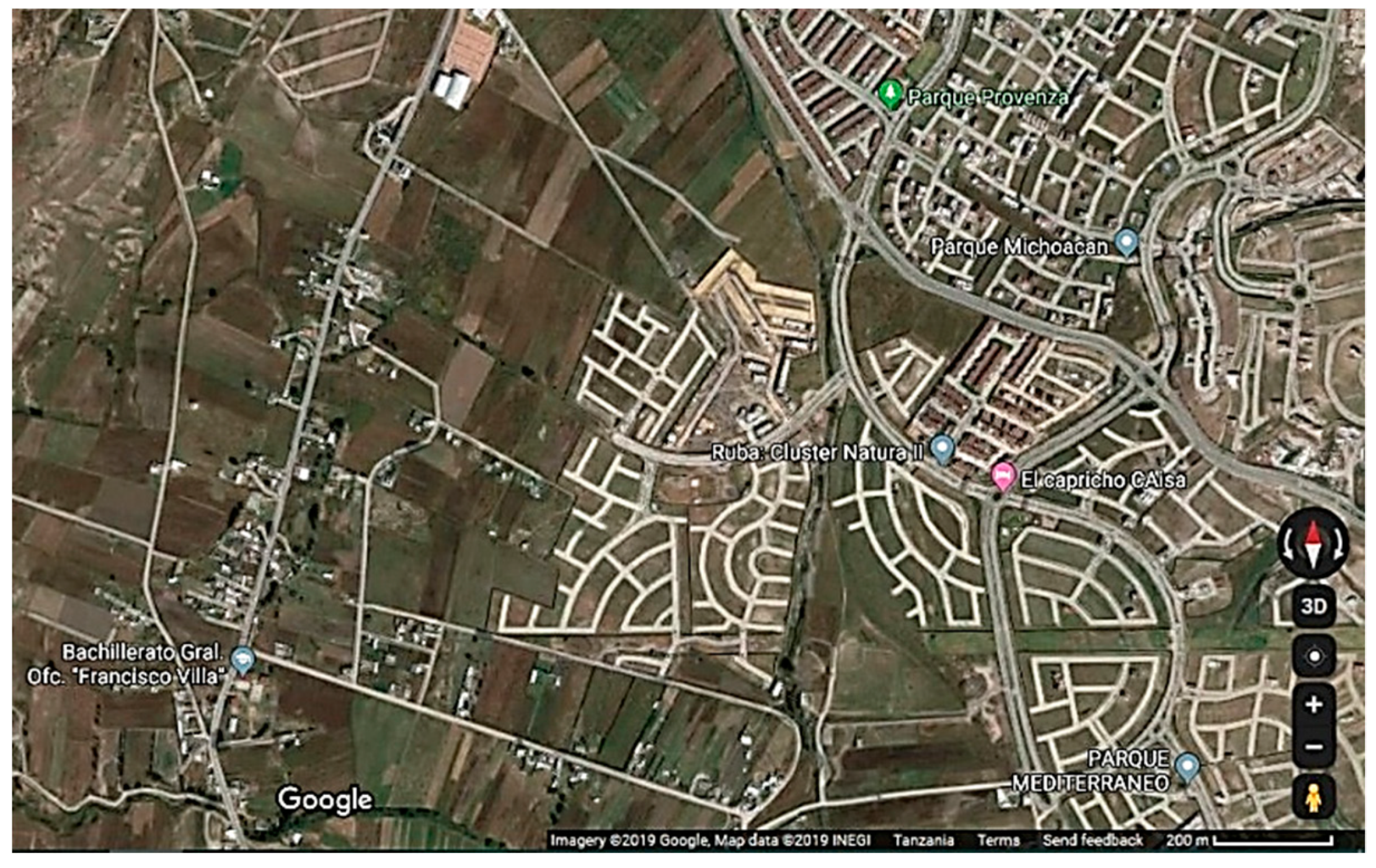
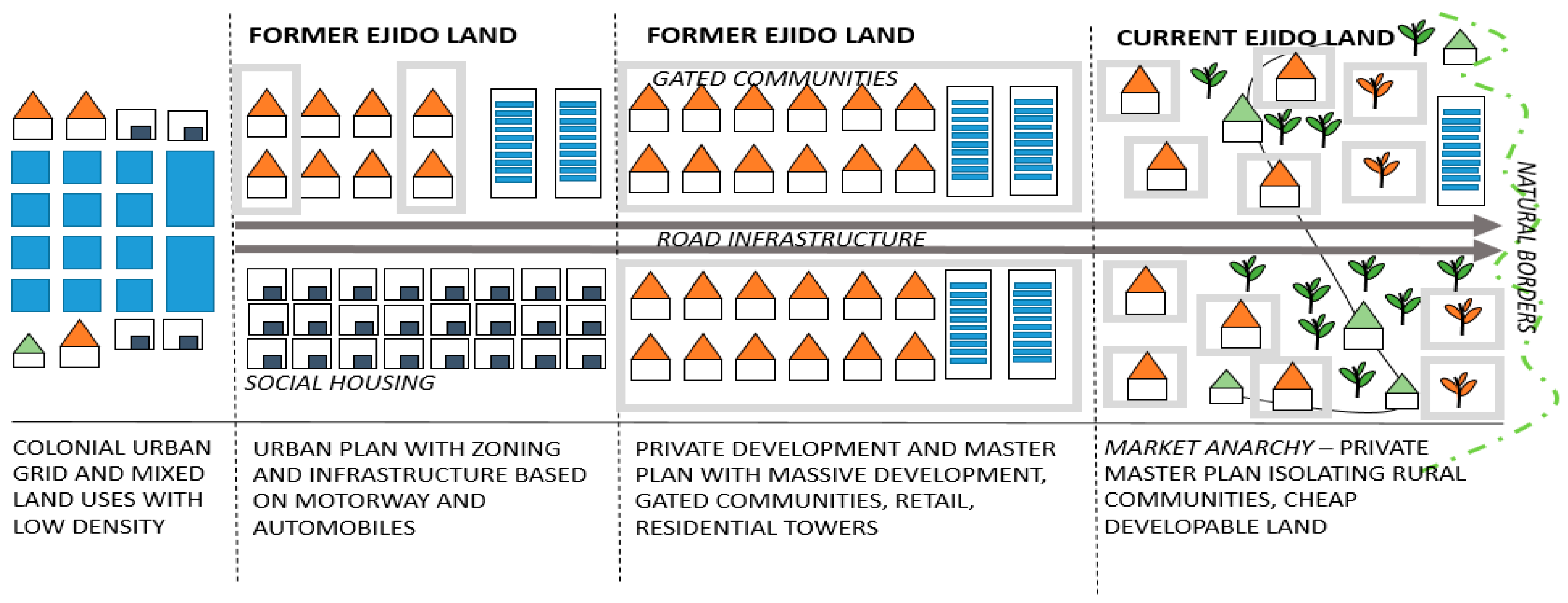
| Agrarian System Features | Hacienda System 19th Century | Agrarian Reform 20th Century | Post-NAFTA 21th Century |
|---|---|---|---|
| Land tenure | Large estates | Ejido, land distribution policies | Private ownership and urbanization of communal and ejido land |
| Ancestral communal land | Small private properties | ||
| Population concentrated in small villages and towns | Restrictions from ejidos regarding the open-land market | ||
| Capital | Agro-industrial production | Public capital, subsidy policies to ejidos, public loans | Subsidies to the agrarian sector |
| Landlord investment | Protection of the National market | International and private investment for the agrarian industry | |
| Rise and fall of agrarian productivity | Importation of corn, grains and agricultural commodities from the USA and other countries | ||
| International exportation of agricultural commodities | Beginning of the importation of grains and goods from the USA | ||
| Labor | Cheap farming and peasant labor for Haciendas | Self-consumption and individual production | Agro-industrial production, self-production |
| “Wage slavery” system | Rural–urban migration | Rural labor migration to the USA | |
| Abandonment of agricultural activities in Mexico | |||
| Technology | Hacienda’s technology for agro-industrialization | Free distribution of farm equipment, livestock and farm goods to ejidatarios by subsidies | Private development for agro-companies |
| Technical training from the State to the ejidatarios | Distribution of farm goods from the State to small farmers | ||
| Subsidies through rural and agricultural development projects | |||
| Organization | Landlords controlled the economy, commerce, transportation and labor structure. | Rural collectives | Rural–local collectives, small producers, the association of small producers and rural cooperatives with big agro-industries |
| Family labor organization inside and outside the ejidos for survival | “Employees in their own land” through a Neo-Latifundium system based on private investment and development. Peasants and farmers produce for big companies | ||
| Ejidatarios’ labor unions |
| Municipality | 1990 | 2000 | 2010 | 2015 | DENSITY |
|---|---|---|---|---|---|
| San Andrés Cholula (77.182 km2) | 37,788 | 56,066 | 100,439 | 137,290 | 2171.7 pop/km2 |
| Pop. Growth | 2.5% | 5.8% | 7% | ||
| Santa Clara Ocoyucan (120.165 km2) | 17,708 | 23,619 | 25,720 | 28,220 | 214 pop/km2 |
| Pop. Growth | 2.9% | 0.8% | 2.0% | ||
| Puebla (Capital) (548.889 km2) | 1,057,454 | 1,346,916 | 1,539,819 | 1,576,259 | 2805.34 pop/km2 |
| Pop. Growth | 2.5% | 1.3% | 0.6% | ||
| Metropolitan Area of Puebla-Tlaxcala (2394.4 km2) | 1,776,884 | 2,269,995 | 2,728,790 | 2,941,989 | 76.6 pop/Ha |
| Pop. Growth | 2.5% | 1.8% | 1.6% |
| Municipality and Ejidos before 1995 | Total Hectares of Ejidos in 1995 | Urban Development after 1995 | Total Hectares of Ejidos Transformed into Urban Areas From 1995 to 2018 |
|---|---|---|---|
| SAN ANDRÉS CHOLULA | |||
| Ejido San Andrés Cholula | 1986.00 | Land Reserve Atlixcáyotl—PSDMU | 1222.00 |
| Ejido San Bernardino Tlaxcalancingo | Several gated communities, high-towers and retail areas | ||
| SANTA CLARA OCOYUCAN | |||
| Ejido Emilio Portes Gil | 3614.50 | Lomas de Angelópolis (gated community developed by Grupo Proyecta) | 4204.00 |
| Ejido Santa Clara Ocoyucan | ||||
|---|---|---|---|---|
| STRATA | Hectares | Land use development | 95% confidence interval | 95% confidence interval |
| Cultivation area | ||||
| 1995 | 6665 | 41.70% (Overall Average) | 562 Hectares | 8% |
| 2018 | 4012 | 25% | 255 | 6% |
| Urban | ||||
| 1995 | 1230 | 7.7% | 203 | 16% |
| 2018 | 4204 | 26.30% | 343 | 8% |
| Soil (vacant) | ||||
| 1995 | 1756 | 11% | 234 | 13% |
| 2018 | 1032 | 6.5% | 264 | 26% |
| Vegetation | ||||
| 1995 | 6336 | 39.63% | 563 | 9% |
| 2018 | 6739 | 42.20% | 383 | 6% |
| TOTAL | 15,987 | 100% | ||
| Atlixcáyotl-Quetzalcóatl Land Reserve | ||||
| STRATA | Hectares | Land use development | 95% confidence interval | 95% confidence interval |
| Cultivation area | ||||
| 1995 | 811 | 66% (Overall Average) | 31 Hectares | 4% |
| 2018 (Vacant Land) | 447 | 36% | 46 | 10% |
| Urban | ||||
| 1995 | 410 | 33% | 31 | 7% |
| 2018 | 775 | 63% | 46 | 6% |
| Total | 1222 | 100% | ||
| Key Aspects and Stakeholders | San Andrés Cholula | Santa Clara Ocoyucan | ||
|---|---|---|---|---|
| Positive aspects | Negative aspects | Positive aspects | Negative aspects | |
| PSDMU (urban plan) → Local authorities | Plan that managed urban growth | Did not consider local needs | New urban land uses for tax collection. | Urban plan made to benefit urban developers and urban sprawl beyond land reserve |
| Regulations were updated according to private needs. | ||||
| Private master plans → Private investors | National investment | Land use change to benefit land speculation | Local and National investment in infrastructure and housing | Construction of gated communities and luxury buildings that isolate local communities |
| Cadastral and market values → Local authorities and real estate developers | Higher market value, more taxation | Speculation with land market value | Added value through land use change | Cheap ejido and rural land in the borders |
| Rural communities → Ejidatarios and land owners | Added value to land | Expropriation, migration to the USA and abandonment of agricultural activities | Added value to land | Land speculation and intimidation by developers Abandonment of agricultural activities |
| Socio-spatial segregation | Socio-spatial segregation | |||
| New incomers → New inhabitants and local population | Modern areas to live and work in with private security | Very expensive area to buy or live in | Residential areas with new houses, parks, schools, leisure and entertainment areas with private security | Not integrated with local communities |
© 2019 by the authors. Licensee MDPI, Basel, Switzerland. This article is an open access article distributed under the terms and conditions of the Creative Commons Attribution (CC BY) license (http://creativecommons.org/licenses/by/4.0/).
Share and Cite
Schumacher, M.; Durán-Díaz, P.; Kurjenoja, A.K.; Gutiérrez-Juárez, E.; González-Rivas, D.A. Evolution and Collapse of Ejidos in Mexico—To What Extent Is Communal Land Used for Urban Development? Land 2019, 8, 146. https://doi.org/10.3390/land8100146
Schumacher M, Durán-Díaz P, Kurjenoja AK, Gutiérrez-Juárez E, González-Rivas DA. Evolution and Collapse of Ejidos in Mexico—To What Extent Is Communal Land Used for Urban Development? Land. 2019; 8(10):146. https://doi.org/10.3390/land8100146
Chicago/Turabian StyleSchumacher, Melissa, Pamela Durán-Díaz, Anne Kristiina Kurjenoja, Eduardo Gutiérrez-Juárez, and David A. González-Rivas. 2019. "Evolution and Collapse of Ejidos in Mexico—To What Extent Is Communal Land Used for Urban Development?" Land 8, no. 10: 146. https://doi.org/10.3390/land8100146
APA StyleSchumacher, M., Durán-Díaz, P., Kurjenoja, A. K., Gutiérrez-Juárez, E., & González-Rivas, D. A. (2019). Evolution and Collapse of Ejidos in Mexico—To What Extent Is Communal Land Used for Urban Development? Land, 8(10), 146. https://doi.org/10.3390/land8100146







